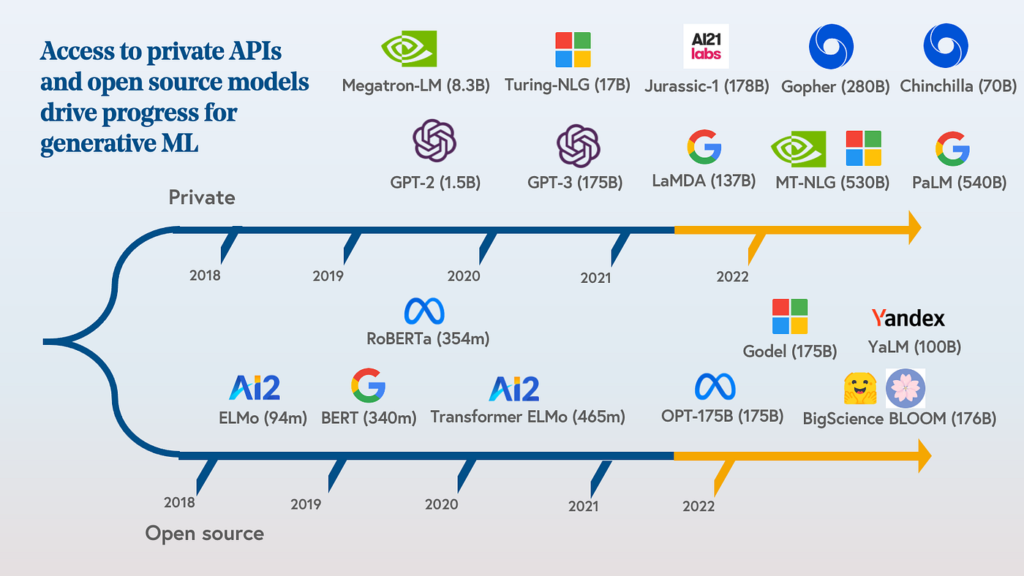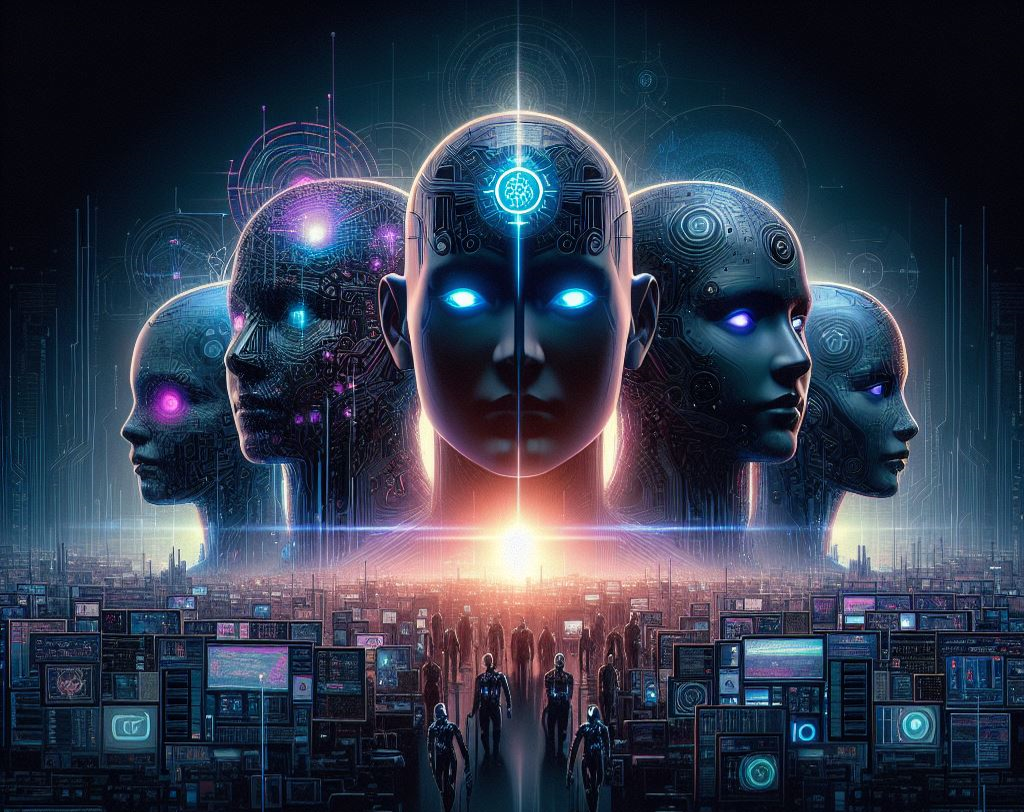1. Introduction: Rise of Artificial Intellgence
We stand at the dawn of a new technological age. 2024 will be the year when generative AI steps out of the shadows and comes into the mainstream. Systems like ChatGPT and DALL-E 2 show just a glimpse of what will soon be possible. As this technology advances, it threatens to disrupt industries and reshape society itself.
Both boundless opportunities and profound risks lie ahead. Those who harness the power of generative AI early could profit tremendously. But uncontrolled, these thinking machines could widen inequality, empower new forms of misinformation, and even escape human understanding. 2024 will be a time of hard choices about how to steer this runaway train toward the most benefit and least harm.
Imagine waking up in the morning and having your personalized virtual assistant automatically write your emails, schedule your meetings, analyze reports, and even create a custom-tailored poem summarizing your dreams. This previously sci-if vision seems poised to arrive before the end of the decade. 2024 is when experts predict advanced systems like ChatGPT and DALL-E cross into the mainstream, radically changing how corporations, governments and small businesses operate. Just a few years later in 2028, Deloitte estimates generative AI could contribute over $15 trillion annually to the global economy by automating repetitive tasks, empowering workers, and unlocking human creativity like never before. However, without judicious governance and foresight on managing risks, we could face rising inequality, fragmentation, and even threats to societal stability. 2024 will be the pivotal year for steering between these poles to shape the future trajectory of thinking machines.
2. The Evolution of Generative AI
To understand the significance of 2024, we must trace the evolution of Generative AI. From its inception to the current state, we explore how this technology has evolved and matured, setting the stage for the monumental advancements expected in the coming year.
Generative AI can create virtually any type of content on demand. Feed it a prompt, and out pops synthetic text, code, images, video or audio—often indistinguishable from human-made creations. As the algorithms improve, so too does the quality, diversity and specificity of their outputs. By 2024, expect generative AI to excel at a wide range of tasks.
- Writing personalized emails, reports, blog posts at superhuman speeds
- Composing music, screenplays, poetry tailored to your tastes
- Designing website layouts, logos, marketing materials
- Developing software applications by translating concepts into code
- Creating PHOTOREALISTIC fake photos and videos of people or events that never occurred
3. Key Players in the AI Arena

In the competitive landscape of AI, companies like Google, Microsoft, and startups like OpenAI and NVIDIA are at the forefront. Google’s BERT (Bidirectional Encoder Representations from Transformers) has become a linchpin in natural language processing, influencing search algorithms to provide more contextually relevant results.
4. Generative AI in the Workplace and Society
As generative AI diffuses through the economy, demand for various human skills will shift. Rote information lookup, transcription services, basic graphic design work and even entry level journalism seem likely to be handed off to algorithms.
Displaced workers will need to specialize in areas computers can’t yet match, like abstract strategy, nuanced persuasion, creative innovating and complex people management. STEM skills will be highly prized. Value also lies in roles requiring social-emotional skills: nursing, therapy, complicated sales, plus human leadership.
On the positive side, generative AI should allow organizations to operate far more efficiently. Meeting minutes, financial reports and most routine business documents could be created instantly. Seniors, non-native speakers and those with disabilities like blindness or deafness will have technology assist them towards new capabilities and independence. There is a huge possibilty in every industry to use ai.

- Healthcare:
- Generative AI can create patient chatbots for personalized medical advice based on full health histories.
- Automated blood analysis startups aim to expand access and reduce healthcare costs.
- Keeping human doctors updated about emerging research.
- Financial Institutions:
- Fidelity Investments and similar organizations use language models for generating market summaries, newsletters, and robo-advisor recommendations.
- OpenAI’s technology could contribute over $200 billion in GDP through workflow automation in reports, legal reviews, and documentation.
- Retail:
- Ecommerce leaders can leverage generative AI to create on-demand product images and descriptions.
- Tailoring catalogs to individual browsing history and regional trends.
- Envisioning custom clothing designed for each customer’s body measurements and style preferences to reduce waste and overproduction.
- Media and Literature:
- Author Robin Sloan utilized AI tools for creating the bestselling novel ‘Anthropic Bias.’
- The potential for machines to generate books, news articles, VFX scenes, and other media artifacts with just a text prompt by 2028.
- Caution about risks associated with relying on ‘black box’ algorithms in content generation.
5. The Urgency of AI Ethics and Governance

As generative models grow more powerful, they may become too complex for even their creators to fully understand. Researchers warn these algorithms could “overfit” by absorbing harmful biases and misinformation lurking within their training data.
For example, a news-writing bot could amplify toxic conspiracies, inflammatory rumors or racist ideologies…all while sounding persuasive, coherent and even ground in evidence. Readers might struggle to identify the deception.
Powerful generative models may also be deliberately misused to generate:
- Deepfake photos/videos distorting public figures and vulnerable individuals
- Automated disinformation campaigns across social networks
- Spear-phishing content for cyber attacks
- Polluting search engine results with spam or malicious code
Tech giants will invest heavily in bias testing and safety controls. But near total generative content creation within a decade seems likely. Just a tiny loss of control poses societal risk.
Hard governance choices lie ahead regarding if, when and how generative AI should be restricted to protect the public interest. The window for self-regulation is rapidly closing. 2024 must be the year global dialogue on AI priorities takes center stage.
6. Conclusion: Embracing the Rise of Thinking Machines
In concluding our exploration, the integration of Generative AI into real-world scenarios showcases its transformative power. From entertainment and healthcare to security and societal initiatives, the rise of thinking machines is not just a theoretical concept but a tangible force shaping the world in 2024 and beyond. Embracing this evolution ensures that AI becomes a driving force for positive change, enriching our lives in ways we have only begun to imagine.
Discover more from WireUnwired Research
Subscribe to get the latest posts sent to your email.




